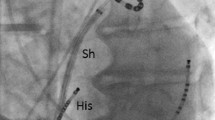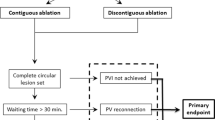Abstract
Background
Despite reports of remote pulmonary vein (PV) stenosis after visually guided laser balloon (VGLB) ablation, circumferential (360°) lesion sets are routinely performed. This study aimed to determine whether fully circumferential lesion creations are required for all PVs to achieve PV isolations (PVIs) and to determine PV’s vulnerability to chronic-phase stenosis.
Methods
Fifty-one patients with paroxysmal atrial fibrillation underwent mapping-guided PVIs using circular mapping catheters. VGLB ablation was performed circumferentially beginning at the 12 o’clock position and continued clockwise or counterclockwise. PVIs obtained within the bounds of the first half of the circumferential lesion (≤ 180°) were defined as “early PVIs.”
Results
“Early PVIs” were documented in real time for 39% (80/204) of the PVs and at a significantly greater frequency among lower PVs than upper PVs (60.1% vs. 17.6%; p < 0.0001). The PV sleeve length, PV diameter, and isolation of ipsilateral PVs within a semicircular lesion set were identified as predictors of an “early PVI” phenomenon. The amount of energy delivered to the lower PVs was significantly less than that to the upper PVs (5553 [5089–6188] vs. 3559 [2793–4380] J; p < 0.0001), but the incidence of narrowing of the lower PVs at 6 months was comparable to that of the upper PVs (p = 0.73).
Conclusion
Our study revealed electrical isolations of more than 60% of the lower PVs while creating the first half of the circumferential lesions. Crosstalk via the carina region was presumably involved due to the preceding upper PVI. Further study is needed to determine whether energy delivery adjustments are needed for lower PVs to avoid chronic narrowing.




Similar content being viewed by others
Data availability
Not applicable.
Code availability
Not applicable.
References
Chun JKR, Bordignon S, Last J, et al. Cryoballoon versus laserballoon: insights from the first prospective randomized balloon trial in catheter ablation of atrial fibrillation. Circ Arrhythm Electrophysiol. 2021;14(2):e009294.
Dukkipati SR, Kuck KH, Neuzil P, et al. Pulmonary vein isolation using a visually guided laser balloon catheter: the first 200-patient multicenter clinical experience. Circ Arrhythm Electrophysiol. 2013;6(3):467–72.
Yamamoto T, Takahashi Y, Yamaguchi J, et al. Pulmonary vein narrowing after visually guided laser balloon ablation: occurrence and clinical correlates. J Cardiovasc Electrophysiol. 2020;31(7):1597–605.
Ogawa T, Yamashita S, Oseto H, et al. Pulmonary vein angioplasty for pulmonary vein stenosis after ablation therapy for atrial fibrillation- a report of 7 cases. Circ J. 2022;86(8):1229–36.
Miyazaki S, Kajiyama T, Watanabe T, et al. Impact of electrical connections between ipsilateral pulmonary veins on the second-generation cryoballoon ablation procedure. J Cardiovasc Electrophysiol. 2019;30(1):27–31.
Gal P, Smit JJJ, Adiyaman A, Ramdat Misier AR, Delnoy P, Elvan A. A new circular mapping-guided approach for endoscopic laser balloon pulmonary vein isolation. Int J Cardiol Heart Vasc. 2015;8:68–72.
Nagase T, Seki R, Asano S, et al. Evaluation of different ablation strategies verifying the optimal overlap ratio in point-by-point laser balloon ablation for patients with atrial fibrillation. Heart Rhythm O2. 2021;2(4):347–54.
Packer DL, Kowal RC, Wheelan KR, et al. Cryoballoon ablation of pulmonary veins for paroxysmal atrial fibrillation: first results of the North American Arctic Front (STOP AF) pivotal trial. J Am Coll Cardiol. 2013;61(16):1713–23.
Cabrera JA, Ho SY, Climent V, Fuertes B, Murillo M, Sanchez-Quintana D. Morphological evidence of muscular connections between contiguous pulmonary venous orifices: relevance of the interpulmonary isthmus for catheter ablation in atrial fibrillation. Heart Rhythm. 2009;6(8):1192–8.
Takahashi A, Iesaka Y, Takahashi Y, et al. Electrical connections between pulmonary veins: implication for ostial ablation of pulmonary veins in patients with paroxysmal atrial fibrillation. Circulation. 2002;105(25):2998–3003.
Gao X, Chang D, Bilchick KC, et al. Left atrial thickness and acute thermal injury in patients undergoing ablation for atrial fibrillation: laser versus radiofrequency energies. J Cardiovasc Electrophysiol. 2021;32(5):1259–67.
Ucer E, Fredersdorf S, Jungbauer CG, et al. Unmasking the dormant pulmonary vein conduction with adenosine administration after pulmonary vein isolation with laser energy. Europace. 2015;17(9):1376–82.
Ellis CR, Saavedra P, Kanagasundram A, et al. Pulmonary vein sleeve length and association with body mass index and sex in atrial fibrillation. JACC Clin Electrophysiol. 2018;4(3):412–4.
Lin YJ, Tsao HM, Chang SL, et al. The distance between the vein and lesions predicts the requirement of carina ablation in circumferential pulmonary vein isolation. Europace. 2011;13(3):376–82.
Yoshida K, Baba M, Shinoda Y, et al. Epicardial connection between the right-sided pulmonary venous carina and the right atrium in patients with atrial fibrillation: a possible mechanism for preclusion of pulmonary vein isolation without carina ablation. Heart Rhythm. 2019;16(5):671–8.
Nagase T, Bordignon S, Perrotta L, et al. Low risk of pulmonary vein stenosis after contemporary atrial fibrillation ablation- lessons from repeat procedures after radiofrequency current, Cryoballoon, and Laser Balloon. Circ J. 2018;82(6):1558–65.
Author information
Authors and Affiliations
Contributions
All authors contributed to the manuscript. The first draft of the manuscript was written by Hirotsugu Sato and all authors commented on the previous versions of the manuscript. All authors read and approved the final manuscript.
Corresponding author
Ethics declarations
Ethics approval
The Bioethics Committee of Dokkyo Medical University Saitama Medical Center approved the study protocol (acceptance number: 21048).
Consent to participate
Informed consent was obtained from the patient before the procedure.
Consent for publication
Patients signed informed consent regarding publishing their data and photographs.
Conflict of interest
Dr. Nakahara received speaker honoraria from Japan Lifeline Co. Other authors have no financial or proprietary interests in any material discussed in this article.
Additional information
Publisher's note
Springer Nature remains neutral with regard to jurisdictional claims in published maps and institutional affiliations.
Rights and permissions
Springer Nature or its licensor holds exclusive rights to this article under a publishing agreement with the author(s) or other rightsholder(s); author self-archiving of the accepted manuscript version of this article is solely governed by the terms of such publishing agreement and applicable law.
About this article
Cite this article
Sato, H., Nakahara, S., Fukuda, R. et al. Is creation of a fully circumferential lesion set necessary for laser balloon ablation-based pulmonary vein isolation?. J Interv Card Electrophysiol 66, 701–710 (2023). https://doi.org/10.1007/s10840-022-01396-6
Received:
Accepted:
Published:
Issue Date:
DOI: https://doi.org/10.1007/s10840-022-01396-6




